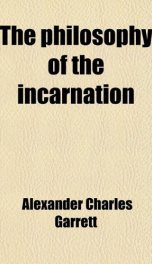the philosophy of the incarnation

Purchase of this book includes free trial access to www.million-books.com where you can read more than a million books for free. This is an OCR edition with typos. Excerpt from book: LECTURE IV. THE PERSON OF CHRIST. "The Word was made flesh."John i. 14. THE point of view of the three synoptic Gospels is different from that of St. John. They see the dawn of the Gospel day, mark the rise of the " Sun of Righteousness," trace His course through tears and sorrow to His setting in blood, note His rising again, and look steadily down the changing centuries until they see Him coming in the clouds with power and great glory to judge the world. St. John does this indeed, but more also. He looks backward to the eternity before the dawn. Taking up the great truth of the three preceding Gospels in which Christ is plainly set forth as the final consummation of all things in heaven and earth, St. John points out that He was also the First, the Beginning, the Origin of all things. Here is a truly profound harmony. The first three Gospels look forward, the fourth looks backward. They observe the goal, this the Source of all power and life. They follow the Son of Man to His seat upon the throne of His glory, St. John beholds the Son.of God ere yet the world was. St. John thus goes back to the very beginning and unveils the Eternal Son inHis Cosmic relation. The whole plan of the universe, ere yet the foundations of the world were laid, is thus seen to lie in its ideal germ in Him in " Whom are hid all the treasures of wisdom and knowledge." As it unfolds in regular order the various parts grow out into dictinctness as the centuries advance. Creation is continuous even as Providence is. " My Father worketh hitherto, and I work," is true all along the ages, and will receive fresh illustration while time remains. I. Creative ideas unfold gradually. Within the range of our telescopes nebulae still appear " without form and void," mere gaseous envelopes assuming spira...
Info about the book
Author:
Series:
Unknown
ISBN:
0486430898
Rating:
4/5 (2)Your rating:
0/5
Languge:
English
Users who have this book
Users who want this book
What readers are saying
What do you think? Write your own comment on this book!
write a commentGenre
if you like the philosophy of the incarnation try:
Other books by this author
Do you want to read a book that interests you? It’s EASY!
Create an account and send a request for reading to other users on the Webpage of the book!

